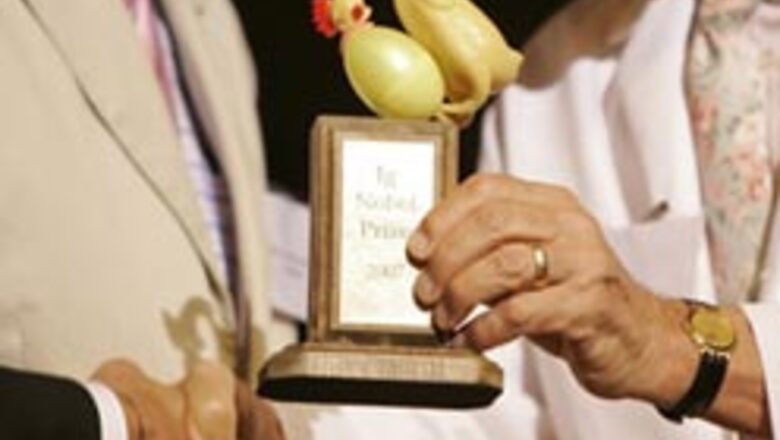
views
Boston: It is a common sight at the buffet table: diners waddling away, belts loosened, clutching their bellies and groaning “Why did I eat so much?”
Cornell University professor Brian Wansink has a reason for the behavior: the more food there is, the more a person will eat. And he has the bottomless bowl of soup to prove it.
''We as Americans judge satiety with our eyes, not with our stomachs,'' he said.
Wansink's research, in which he gave some test subjects regular bowls of creamy tomato soup and some bottomless bowls of soup, earned him and his team of researchers an IgNobel, the annual award handed out by the Annals of Improbable Research magazine for sometimes legitimate but always quirky and funny scientific achievements.
Some of this year's other winners, honoured Thursday night at Harvard University's Sanders Theater, were two men who wrote a penetrating report on the injuries suffered by sword swallowers; a Dutch researcher who conducted a census of all the creepy-crawlies that share our beds; and a man who patented a Batman-like device that drops a net over bank robbers.
In Wansink's experiment, bowls were rigged with tubes that slowly and imperceptibly refilled them.
''We found that people eating from the refillable soup bowls ended up eating 73 percent more soup, but they never rated themselves as any more full,'' said Wansink, a professor of consumer behavior and applied economics. ''They thought 'How can I be full when the bowl has so much left in it?' ''
Dan Meyer of Antioch, Tennessee, USA, and Dr. Brian Witcombe of Gloucester, England, won for their report ‘Sword Swallowing and its Side Effects,’ published in the British Medical Journal last year.
It was the world's first comprehensive study of sword swallowing injuries, said Meyer, one of only a few dozen active sword swallowers in the world. Not surprisingly, throat abrasions, perforated esophagi and punctured blood vessels were the most common injuries.
''Most sword swallowing injuries happen either after another smaller injury when the throat is tender and swollen, or while doing something out of the ordinary, like swallowing multiple swords,'' Meyer said.
PAGE_BREAK
That explains why Meyer went to the hospital and spent a month in bed without solid food in 2005 after puncturing his stomach while swallowing five swords at once.
''I look at every sword and say 'Is this the one that's going to kill me?''' he said.
Harvard professor of applied mathematics L. Mahadevan and professor Enrique Cerda Villablanca of Universidad de Santiago in Chile won for their studies on a problem that has vexed anyone who ever made up a bed: wrinkled sheets.
The wrinkle patterns seen on sheets are replicated in nature on human and animal skin, in science and in technology.
''We showed that you can understand all of them using a very simple formula,'' Mahadevan said.
His research, he says, shows that ''there's no reason good science can't be fun.''
This year's planned IgNobel program included a two-minute speech by keynote speaker Doug Zongker consisting only of the word ''chicken,'' and a mini-opera entitled ''Chicken versus Egg,'' performed by professional mother-daughter opera singers Gail Kilkelly and Maggie McNeil.
Most winners are more than happy to accept their awards from real Nobel Laureates at the typically rowdy ceremony, including seven of the 10 winners this year. But there are still a few stick-in-the-muds, magazine editor Marc Abrahams said.
The US Air Force won the IgNobel Peace Prize this year for its proposal to develop a ''gay bomb'': a chemical weapon that would make enemy soldiers want to make love with each other, not war with the enemy.
Abrahams talked to a number of retired and active Air Force personnel to try and get someone to accept the prize in person on behalf of the military. None would.
''Who in their right mind would turn something like this down?'' Wansink said.


















Comments
0 comment